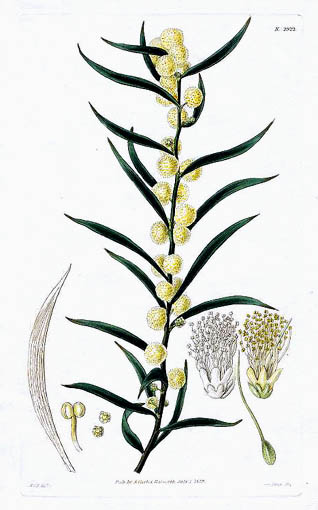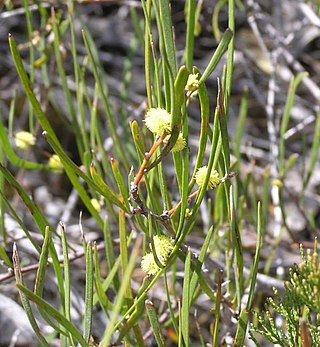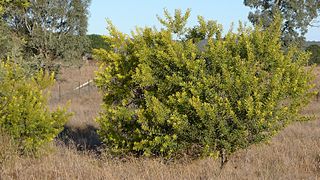
Acacia cultriformis, known as the knife-leaf wattle, dogtooth wattle, half-moon wattle or golden-glow wattle, is a perennial tree or shrub of the genus Acacia native to Australia. It is widely cultivated, and has been found to have naturalised in Asia, Africa, North America, New Zealand and South America. A. cultriformis grows to a height of about 4 m (13 ft) and has triangle-shaped phyllodes. The yellow flowers appear from August to November in its natural range. Its attractive foliage and bright flowers make it a popular garden plant.

Acacia myrtifolia, known colloquially as myrtle wattle, red stem wattle or red-stemmed wattle, is a species of Acacia native to coastal areas of southern and eastern Australia.

Acacia holosericea is a shrub native to tropical and inland northern Australia. It is commonly known as soapbush wattle, soapbush, strap wattle, candelabra wattle, silver wattle and silky wattle.

Acacia brownii, commonly known as heath wattle, is an erect or spreading shrub which is endemic to eastern Australia.

Acacia lanigera, commonly known as woolly wattle or hairy wattle, is a tree species that is endemic south eastern Australia.

Acacia buxifolia, commonly known as box-leaf wattle, is shrub species that is endemic to eastern Australia.

Acacia rigens, commonly known as nealie, is an erect or spreading shrub or small tree that is endemic to Australia. Other common names include needle wattle, needlebush acacia, nealia and nilyah.

Acacia adoxa, commonly known as the grey-whorled wattle, is a species of flowering plant in the family Fabaceae and is endemic to north-western Australia. It is a dense, low-lying shrub with linear, more or less cylindrical phyllodes in whorls of 6 to 10, heads of golden-yellow flowers, and flat, sticky pods.

Acacia asperulacea is a shrub belonging to the genus Acacia and the subgenus Lycopodiifoliae.

Acacia iteaphylla, commonly known as Flinders Range wattle, Port Lincoln wattle, winter wattle and willow-leaved wattle, is a shrub belonging to the genus Acacia and the subgenus Phyllodineae that is endemic to South Australia.

Acacia rossei, also known as Yellowdine wattle, is a shrub of the genus Acacia and the subgenus Phyllodineae that is endemic to south western Australia.

Acacia sphacelata is a shrub of the genus Acacia and the subgenus Phyllodineae that is endemic to south western Australia.

Acacia sclerophylla, commonly known as the hard-leaf wattle, is a shrub of the genus Acacia and the subgenus Plurinerves and is endemic to southern parts of Australia.

Acacia granitica commonly known as the granite wattle is a shrub in the family Fabaceae. Endemic to Australia, it occurs on the New England Tableland of New South Wales and southern Queensland. It is a species tolerant of poor drainage, frost and snow.

Acacia amoena, commonly known as boomerang wattle, is a species of flowering plant in the family Fabaceae and is endemic to south-eastern continental Australia. It is a shapely, erect or spreading shrub with usually lance-shaped to elliptic phyllodes, usually yellow or bright yellow flowers arranged in a raceme of 5 to 21 heads each with 6 to 12 flowers, and straight or curved pods 40–120 mm (1.6–4.7 in) long.

Acacia rubida, commonly known as red stem wattle, red stemmed wattle or red leaved wattle, is a shrub belonging to the genus Acacia and the subgenus Phyllodineae that is native to parts of eastern Australia.

Acacia calamifolia, commonly known as wallowa or reed-leaf wattle, is a shrub or tree belonging to the genus Acacia and the subgenus Phyllodineae endemic to south eastern parts of Australia.

Acacia falciformis, also commonly known as broad-leaved hickory, hickory wattle, mountain hickory, large-leaf wattle, tanning wattle and black wattle, is a shrub belonging to the genus Acacia and the subgenus Phyllodineae that is endemic to eastern Australia

Acacia simmonsiana, commonly known as Simmons wattle or desert manna wattle, is a shrub belonging to the genus Acacia and the subgenus Phyllodineae native to south eastern Australia.

Acacia elongata, also known as swamp wattle or slender wattle, is a shrub of the genus Acacia and the subgenus Plurinerves that is endemic to coastal areas of eastern Australia.























